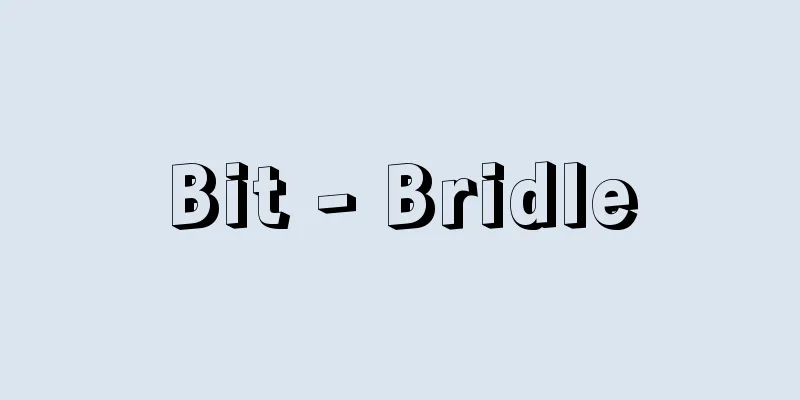Bit - Bridle

|
A piece of horse equipment that is attached to the horse's mouth and used to control the horse with reins. There is a theory that the Japanese word originates from a corruption of the word kuchiwa (muzzle). In the past, it was called "kutsubami," and reins were sometimes called "kutsuwa." The word rokuhami (bridle) or kutsuwahami (bit) can also be used to refer to a bit. Modern bits are made of metal, rubber, nylon, etc. There are two types of bits: short bridles and long bridles. Short bridles have two rod-shaped "bits" with a ring (pulling handle) at the end, and the reins are attached to the ring. Long bridles are made of three parts: the bit, the branch, and the bit chain. The bit is attached to the horse's mouth in the toothless area between the incisors and premolars (the alveolar margin). Humans first attached nose rings to horses, just like they do to cattle, but then invented the bit, cleverly taking advantage of the anatomical structure of the horse's mouth. Bits were initially made from cloth, rope, or leather straps. The oldest fixed bits were made from deer antlers around 2000 BC. Later, they were made from bronze and then iron. Iron bits were introduced to Japan from the Asian continent. Artifacts excavated from the Kofun period have mirror panels on the "bits," revealing the excellent technology of the time. [Shinichi Matsuo] "The History of Japanese Equestrianism, Volume 3" edited by the Japan Riding Association (1940, Dai Nippon Kidokai/Reprint edition, 1980, Hara Shobo)" ▽ "Exploring Ancient Japanese Culture: Horses" edited by Mori Koichi (1979, Shakai Shisosha) ▽ "The History of Riding and Driving" by Kamo Giichi (1980, Hosei University Press) Source: Shogakukan Encyclopedia Nipponica About Encyclopedia Nipponica Information | Legend |
|
ウマの口に取り付け、手綱(たづな)をつけてウマを御する馬具。日本語の起源は口輪(くちわ)から転訛(てんか)したとする説がある。古くは「くつばみ」といい、手綱のことを「くつわ」ということもあった。轡のことを勒(ろくはみ)や銜(くつわはみ)という語を用いることがある。現在の轡は、金属製、ゴム製、ナイロン製などがある。轡には小勒銜(しょうろくばみ)と大勒銜の2種類がある。小勒銜は2個の棒状の「はみ身」とその先端にはみ環(かん)(引き手)があり、はみ環に手綱がつけられる。大勒銜は「はみ身」「はみ枝」「轡鎖(くつわくさり)」の3部からできている。はみの部分はウマの口腔(こうくう)の切歯(せっし)と前臼歯(ぜんきゅうし)との間の歯のない部位(槽間縁(そうかんえん))に取り付ける。 人類は最初、ウシと同じように鼻環をウマに取り付けていたが、ウマの口腔の解剖学的構造を巧みに利用して轡を発明した。轡は、初めは布、綱、革紐(ひも)などが用いられていた。最古の固定した轡としては、紀元前2000年ころ鹿角(ろっかく)製のものが出現している。その後、青銅製から鉄製になっている。日本にはアジア大陸から鉄製の轡が渡来している。古墳時代の出土品には、「はみ身」に鏡板がついていて、当時の優れた技術を知ることができる。 [松尾信一] 『日本乗馬協会編『日本馬術史 第3巻』(1940・大日本騎道会/復刻版・1980・原書房)』▽『森浩一編『日本古代文化の探求・馬』(1979・社会思想社)』▽『加茂儀一著『騎行・車行の歴史』(1980・法政大学出版局)』 出典 小学館 日本大百科全書(ニッポニカ)日本大百科全書(ニッポニカ)について 情報 | 凡例 |
<<: Shoeworm (Mecopoda nipponensis)
>>: Qurrat al-'Ayn (English spelling)
Recommend
Marine observation satellite
The first artificial satellite, GEOS-3, launched b...
Charlot, A. (English spelling) CharlotA
…In the 20th century, the erotic dances of dancer...
Autumn Cherry Blossoms - Autumn Cherry Blossoms
...There are more than 25 species of cosmos nativ...
Romance novel - Engi tai shosetsu
A full-length historical novel written in the mid-...
Infinity and infinitesimal - mugendaimugensho (English spelling) infinite(infinity), infinitesimal
Two new elements, written as +∞ and -∞, are added ...
homonomous metamere
…Arthropods can be found in every environment on ...
Ikedaya Incident - Ikedaya Incident
An attack on the Sonno Joi faction by the Shinsen...
growth movement
…All of these movements are characterized by bein...
schizocarp
...nuts are relatively large, hard-shelled fruits...
Castle guard - Joban
During the Edo period, one of the samurai occupati...
Crystal tea
...The Ainu people used the leaves to make tea. T...
Swastika
The symbol used on the flag of Nazi Germany. Sourc...
Blood pressure monitor
A general term for a device that measures blood p...
Oshu Chrysanthemum
...The tubular petals that extend around the flow...
Timeless and Trendy - Fuekiryuko
Pine pine tree tail oh Ba Ba Banana Sho of Acting...









